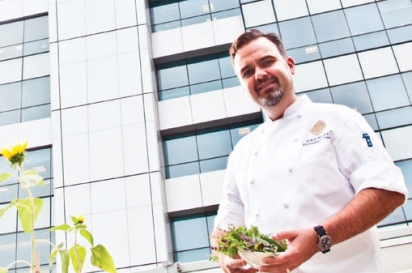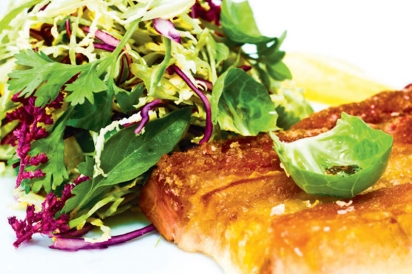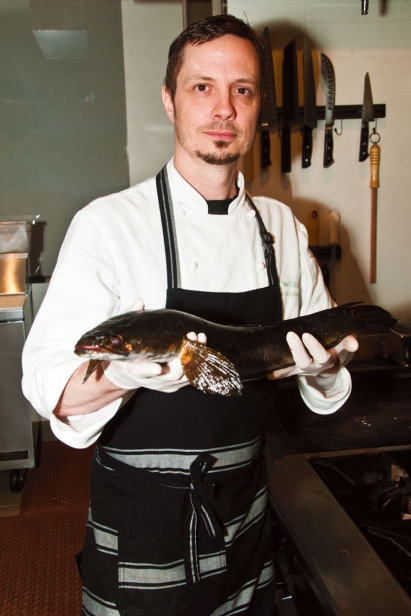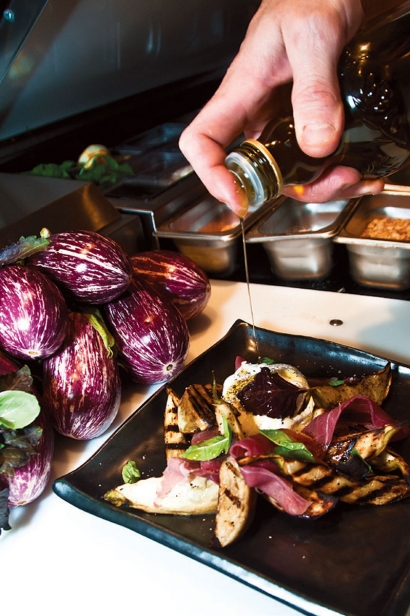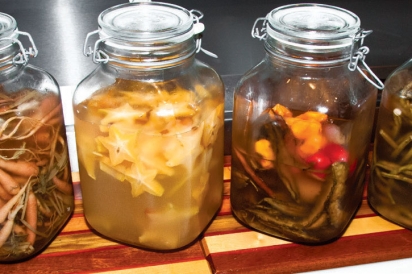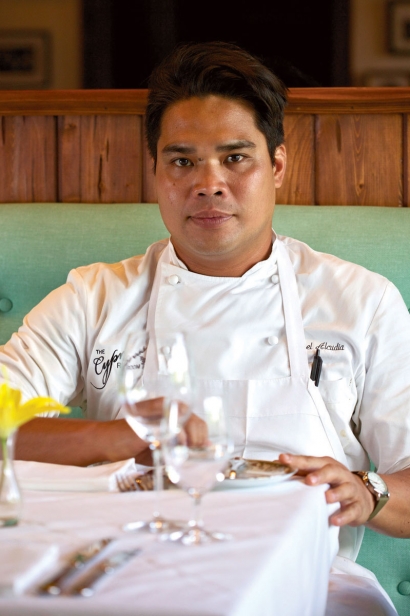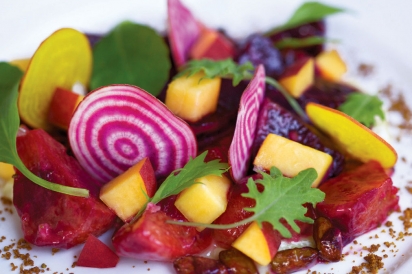The Local Kitchen
There was a time when restaurants took pride in how far their food had traveled to reach your plate. Lamb from New Zealand, truffles from Perigord, fish from Hawaii – choosing your dinner was often more like consulting a world atlas. How things have changed!
Lately, every new restaurant trumpets its "farm to table" ethos, and menus regularly include shout-outs to local purveyors. With increasing consciousness of "food miles," sourcing product anywhere other than locally has become something many chefs try to hide rather than tout. For some restaurants, like Copenhagen's much-celebrated and influential Noma, "local" and "seasonal" are a raison d'être. // For others, those words are just a cynical effort to latch onto the latest trend. For most, though, the reality is something more complex.
There are many virtues – culinary, environmental, societal – to using local, seasonal products, but there are certain practicalities to be faced. South Florida's local food sources are expanding and improving, but they remain limited. This is especially true in the summer when it becomes too hot for most things to grow here, and the universe of available products shrinks dramatically. A true locavore restaurant would struggle to find something to put on the plate all 12 months of the year.
Cooking locally and seasonally requires a variety of different approaches, but most of all, flexibility. I spoke to three local chefs – Matt Hinckley of Box Park, Aaron Brooks of Edge Steak + Bar and Roel Alcudia of The Cypress Room, about how they do it.
AARON BROOKS, EDGE STEAK + BAR
With its steakhouse theme and location inside the Four Seasons Hotel, Edge Steak + Bar may not be the first place you'd expect to find local, seasonal ingredients. But chef Aaron Brooks, an Australian native who has run hotel restaurants around the country, still works to incorporate the local landscape into his cooking by using almost exclusively local fish, pork from a small central Florida farm, and fruits and vegetables from local growers.
Edge isn't a place that wears the whole "farm to table" thing on its sleeve, but I know you make an effort to work with local products. Why does it matter to you?
When I initially got into the trade many moons ago, there was a big movement to always have the best ingredients that were the hardest to get. Chefs were importing cheeses and meats from Europe, flying fruits and vegetables from faraway lands despite seasonal differences and embracing wines from all over the world. It always had me wondering, if we can produce these products domestically of a high quality, why source elsewhere?
What local products do you get particularly excited to work with?
First and foremost, you know I dig my pig. Jim Wood out at Palmetto Creek produces awesome pork. I love working with his hogs. As for seafood, we are surrounded by ocean and beautiful seafood in South Florida. It's a no-brainer. I'm not going to import fish from Europe when I can get product locally that rivals our neighbors across the pond. The local farms like Paradise, Teena's and Swank bring fun stuff to the table. Tropical fruits get me super excited, too. A lot of the interesting stuff here is similar to what we used to get back in Australia.
What do you wish your customers understood better about cooking and eating locally and seasonally?
I feel the general public is becoming more educated about eating local every day. You are seeing more and more farmers markets, community gardens and CSA programs. The folks I meet in the restaurant always have great things to say about what we are doing and the local content we incorporate into our menus. It's even becoming a stronger focus in our schools. As a father I am so passionate about this. I want my kids to know who, what, where and why they are eating the things on their plates.
MATT HINCKLEY, BOX PARK
Box Park is an elegantly modern new restaurant nestled among the tall towers of downtown Brickell. Their mantra is "food unfiltered" – straightforward cooking that highlights the ingredients. Chef Hinckley's approach to cooking locally and seasonally focuses on preservation, as in his "Out of Season Brickell Pickles" and underutilized products, including invasive species like wild boar and nuisance gators, both of which are in his "Everglades Gumbo."
Big picture, what are you trying to do here?
I want to introduce people to ingredients they might not have had before, but in a way that is very approachable and familiar. A lot of the proteins I chose to put on the menu here are proteins you don't find at a chain grocery store very often, if at all. Most of it comes from an ethical principle. I won't buy meat from a farmer who won't let me walk on to the farm, walk around the animals, see what their diet is. I love putting wild boar on the menu. It's an invasive species – they cause a lot of damage to the ecosystem, a lot of the farmers have problems with them digging up sprinkler systems in the groves and whatnot, so I think to put it on the menu is a responsible thing. And they're tasty, too –I think it adds a lot more depth of flavor to a dish.
What is your game plan as far as sourcing locally?
I spent a couple summers working in Alaska, in some places that were really remote. And I got to see a really cool kind of lifestyle where as soon as the ground thawed, people were planting gardens, out shooting moose and catching salmon, and doing all these things. They worked like ants through the whole summer, their vegetables were nuts because you've got 20 hours of sunlight – carrots as long as your arm – and at the end of the summer, everybody got together at this community center and I would trade you my bear jerky for your gravlax or smoked salmon or pickles from your garden or honey. That's what got everyone through the winter – as soon as the ground froze, that was it.
It's a big contrast obviously between Alaska and Miami, but you go through the same kind of thing. When we were growing everything down here, we'd try to buy up as much as we could to support the local farmers. We're pickling it, turning it into kimchis, trying to find ways to prolong the season. Likewise in the summer we find an overabundance of mangos and we're turning them into jams and jellies. When the winter rolls around and mangos are scarce, we'll have mango jam on the brunch menu or we'll have mango pickles and preserves or mostardas for the charcuterie. We have all these things we're sandbagging so we can use stuff that's fresh when it's in season, but also have things that are out of season on the menu. It shows the diversity of what Florida agriculture has to offer.
How about seafood?
I use George Figueroa (of Trigger Seafood), he's a good friend of ours. I don't even tell him what I want. I say "George, send me fish." So whatever they yank out of the sea and bring over to me, is what I'm going to cook. I try to use as much invasive stuff as I can. I [started] using Asian snakeheads, a real problematic species in the Everglades, just chomping up the bass population.
How do you balance change and predictability in your menu as you try to adapt to the seasons and product availability?
If I was trying to do a 300-seat restaurant with this menu it'd be a whole other animal. I don't think we'd enjoy the same success we have in a smaller, more intimate environment. I think the people we're reaching out to are embracing the fact that it's locally sourced, small farms, responsible.
ROEL ALCUDIA, THE CYPRESS ROOM
In late March, The Cypress Room opened as a more upscale sibling to Michael's Genuine Food & Drink, a restaurant that spurred the farm-to-table focus in Miami. To helm the kitchen, Michael Schwartz brought in Roel Alcudia, who had previously worked at Barbuto in New York, another pioneer of local, seasonal cooking. The multi-course tasting menus at Cypress Room regularly feature local fish and the products of local farms.
When MGFD first opened, it was very much at the forefront of the local, farm-to-table movement here. How does that fit with what Cypress Room is trying to do?
What we're trying to accomplish is similar, but a little more refined: not taking shortcuts, using local ingredients whenever possible. There are only a few components on the plate, but it's the best of the best. We have more of a "fine dining" edge, but I don't really consider this a fine dining restaurant, it's just more nostalgic. We didn't want to go too far and start using tweezers on the plate, so we kind of just went back to "honest cooking."
Here we wanted the menu to change more on a quarterly basis, not a daily basis. But right now it's kind of tough to do "local."
Well, you arrived right as we stopped growing everything.
It's tough for me to not have tomatoes in September! Right now what's local on the menu is the long beans from Homestead, the calabazas, the raw fish crudo. It's taken time for me to adapt instead of trying to force something. You kind of just have to dig deep into your cookbooks. For me, I had this picture of Florida as a jungle paradise, you grow everything down here – I didn't realize it was basically a rock. So I've had to adapt, go down there, see what they can grow for us and have to offer.
Do you request that farms grow things for you?
We have a very close relationship with (local farmer) Michael Borek. So actually right now we're in the middle of picking through seed catalogs and having them grow things for us so we can have specialized stuff. For me, it's about the connection between the farmers and the chef. You take out the middle – instead of having the farmer guess, we can say "Why don't we tell you what to grow, and we'll buy it?"
You update the regular menu seasonally. It seems whatever is growing that particular week or that particular month, the tasting menu is more of an opportunity to weave that in.
The tasting menu is great because it gives the kitchen and me flexibility with different products to use, different aesthetics. That's also why the menu is written so vaguely – it gives us more leeway. You don't want to commit and print menus every day when the littlest things like – you know, the nectarines are better than the peaches this day – so it just says "stone fruit." So it can be whatever we have that's best.
Do the restaurants source collectively or does each restaurant do its own buying?
We have this guy, he has this business called Farm to Kitchen, he uses our van and goes to Homestead, to Paradise Farms and Teena's Pride, and a couple other farms, and sees what they have and gathers for the whole restaurant group. He'll send us a list, and the list will say, "This is what we have, this is what they're growing," and we'll choose what to buy. And then our last line is always "Is anything interesting and new? Give us a call and we'll find something to do with it."



